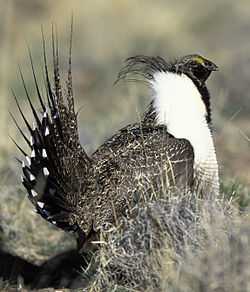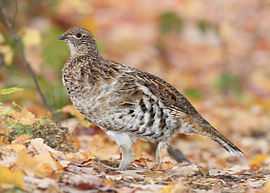Grouse
| Grouse | |
|---|---|
 | |
| Male sage grouse Centrocercus urophasianus | |
| Scientific classification | |
| Kingdom: | Animalia |
| Phylum: | Chordata |
| Class: | Aves |
| Subclass: | Neornithes |
| Infraclass: | Galloanserae |
| Order: | Galliformes |
| Family: | Phasianidae |
| Subfamily: | Tetraoninae Vigors, 1825 |
| Genera | |
|
Bonasa | |
| Synonyms | |
|
Tetraonidae Vigors, 1825 | |
Grouse /ˈɡraʊs/ are a group of birds from the order Galliformes, in the family Phasianidae. Grouse are frequently assigned to the subfamily Tetraoninae (sometimes Tetraonidae), a classification supported by mitochondrial DNA sequence studies,[1] and applied by the American Ornithologists' Union,[2] ITIS,[3] and others.[4] Grouse inhabit temperate and subarctic regions of the northern hemisphere, from pine forests to moorland and mountainside,[5] from 83° North (rock ptarmigan in northern Greenland) to 28° North (Attwater's prairie chicken in Texas).[6]
Description
Grouse are heavily built like other Galliformes such as chickens. They range in length from 31 to 95 cm (12 to 37 in), and in weight from 0.3 to 6.5 kg (0.66 to 14.33 lb). Males are bigger than females—twice as heavy in the western capercaillie, the biggest member of the family. Grouse have feathered nostrils. Their legs are feathered to the toes, and in winter the toes, too, have feathers or small scales on the sides, an adaptation for walking on snow and burrowing into it for shelter. Unlike other Galliformes, they have no spurs.[6]
Feeding and habits
These birds feed mainly on vegetation—buds, catkins, leaves, and twigs—which typically accounts for over 95% of adults' food by weight. Thus their diets vary greatly with the seasons. Hatchlings eat mostly insects and other invertebrates, gradually reducing their proportion of animal food to adult levels. Several of the forest-living species are notable for eating large quantities of conifer needles, which most other vertebrates refuse. To digest vegetable food, grouse have big crops and gizzards, eat grit to break up food, and have long intestines with well-developed caeca in which symbiotic bacteria digest cellulose.[6]
Forest species flock only in autumn and winter, though individuals tolerate each other when they meet. Prairie species are more social, and tundra species (ptarmigans, Lagopus) are the most social, forming flocks of up to 100 in winter. All grouse spend most of their time on the ground, though when alarmed, they may take off in a flurry and go into a long glide.[6]
Most species stay within their breeding range all year, but make short seasonal movements; many individuals of the ptarmigan (called rock ptarmigan in America) and willow grouse (called willow ptarmigan in America) migrate hundreds of kilometers.[6]
Reproduction
In all but one species (the Willow Ptarmigan), males are polygamous. Many species have elaborate courtship displays on the ground at dawn and dusk, which in some are given in leks. The displays feature males' bright-colored combs and in some species, bright-colored inflatable sacs on the sides of their necks. The males display their plumage, give vocalizations that vary widely between species, and may engage in other activities, such as drumming or fluttering their wings, rattling their tails, and making display flights. Occasionally, males fight.[6]
The nest is a shallow depressions on the ground, often in cover, with a scanty lining of plant material. The female lays one clutch, but may replace it if the eggs are lost. She begins to lay about a week after mating and lays one egg every day or two; the clutch comprises five to 12 eggs. The eggs have the shape of hen's eggs and are pale yellow, sparsely spotted with brown. On laying the second-last or last egg, the female starts 21 to 28 days of incubation. Chicks hatch in dense, yellow-brown down and leave the nest immediately. They soon develop feathers and can fly shortly before they are two weeks old. The female (and the male in the willow grouse) stays with them and protects them until their first autumn, when they reach their mature weights (except in the male Capercaillies). They are sexually mature the following spring, but often do not mate until later years.[6]
Populations

Grouse make up a considerable part of the vertebrate biomass in the Arctic and Subarctic. Their numbers may fall sharply in years of bad weather or high predator populations—significant grouse populations are a major food source for lynx, foxes, martens, and birds of prey. However, because of their large clutches, they can recover quickly.
The three tundra species have maintained their former numbers. The prairie and forest species have declined greatly because of habitat loss, though popular game birds such as the red grouse and the ruffed grouse have benefited from habitat management. Most grouse species are listed by the IUCN as "least concern" or "near threatened", but the greater and lesser prairie chicken are listed as "vulnerable" and the Gunnison grouse is listed as "endangered". Some subspecies, such as Attwater's Prairie Chicken and the Cantabrian capercaillie, and some national and regional populations are also in danger.[6]
In culture
Grouse are game, and hunters kill millions each year for food, sport, and other uses. In the United Kingdom this takes the form of driven grouse shooting. The male black grouse's tail feathers are a traditional ornament for hats in areas such as Scotland and the Alps. Folk dances from the Alps to the North American prairies imitate the displays of lekking males.[6]
Species
Genus Falcipennis
- Siberian grouse, Falcipennis falcipennis
- Spruce grouse, Falcipennis canadensis
- Franklin's grouse, Falcipennis (canadensis) franklinii
Genus Dendragapus
- Dusky grouse, Dendragapus obscurus
- Sooty grouse, Dendragapus fuliginosus
Genus Lagopus – ptarmigans
- Willow ptarmigan, Lagopus lagopus
- Red grouse, Lagopus (lagopus) scoticus
- Rock ptarmigan, Lagopus muta
- White-tailed ptarmigan, Lagopus leucura
Genus Tetrao – black grouse
- Black grouse, Tetrao tetrix
- Caucasian grouse, Tetrao mlokosiewiczi
- Western capercaillie, Tetrao urogallus
- Cantabrian capercaillie, Tetrao urogallus cantabricus
- Black-billed capercaillie, Tetrao Tetrao urogalloides
Genus Tetrastes
- Hazel grouse, Tetrastes bonasia
- Chinese grouse, Tetrastes sewerzowi
Genus Bonasa
- Ruffed grouse, Bonasa umbellus
Genus Centrocercus – sage grouse
- Sage grouse, Centrocercus urophasianus
- Gunnison grouse, Centrocercus minimus
Genus Tympanuchus – prairie grouse
- Sharp-tailed grouse, Tympanuchus phasianellus
- Columbian sharp-tailed grouse, T. phasianellus columbianus
- Greater prairie chicken, Tympanuchus cupido
- Attwater's prairie chicken, Tympanuchus cupido attwateri
- Heath hen, Tympanuchus cupido cupido (extinct, 1932)
- Lesser prairie chicken Tympanuchus pallidicinctus
References
Footnotes
- ↑ Gutiérrez, R. J.; Barrowclough, G. F.; Groth, J. G. (2000). "A classification of the grouse (Aves: Tetroninae) based on mitochondrial DNA sequences" (PDF). Wildlife Biology 6 (4): 205–212.
- ↑ "AOU Checklist of North and Middle American Birds". American Ornithologists' Union. Retrieved 2014-03-13.
- ↑ "Tetraoninae". Integrated Taxonomic Information System. Retrieved 2013-03-13.
- ↑ Boyd, John. "Phasianidae: Turkeys, Grouse, Pheasants, Partridges". Aves – A taxonomy in flux. Retrieved 2014-03-13.
- ↑ Rands, Michael R.W. (1991). Forshaw, Joseph, ed. Encyclopaedia of Animals: Birds. London: Merehurst Press. p. 91. ISBN 1-85391-186-0.
- ↑ 6.0 6.1 6.2 6.3 6.4 6.5 6.6 6.7 6.8 Storch, Ilse; Bendell, J. F. (2003). "Grouse". In Perrins, Christopher. The Firefly Encyclopedia of Birds. Firefly Books. pp. 184–187. ISBN 1-55297-777-3.
General
De Juana, E. (1994). "Family Tetraonidae (Grouse)". In del Hoyo, J.; Elliott, A.; Sargatal, J. Handbook of the Birds of the World, Vol. 2. New World Vultures to Guineafowl. Barcelona: Lynx Edicions. pp. 376–411. ISBN 84-87334-15-6.
External links
| Wikimedia Commons has media related to Tetraoninae. |
- Grouse videos on the Internet Bird Collection
- P. Johnsgard, "Etho-Ecological Apects of Hybridization in the Tetraonidae," World Pheasant Association Journal VII (1982), pp. 42–57.
| |||||||||||||||||||||||||||||||||

